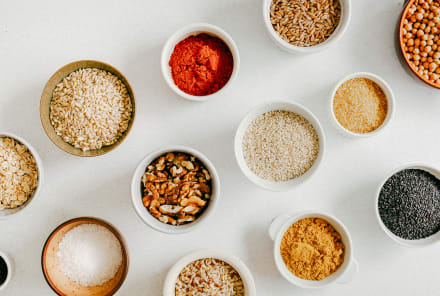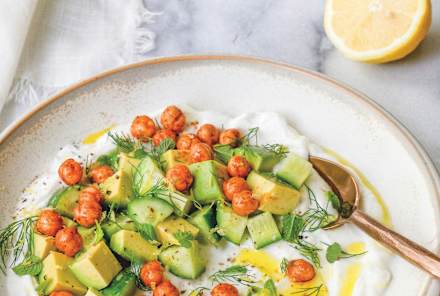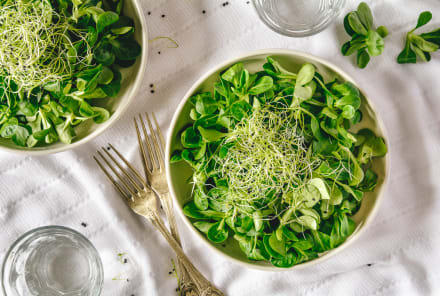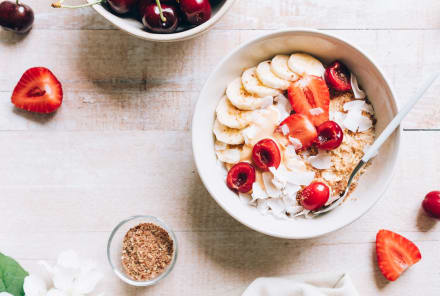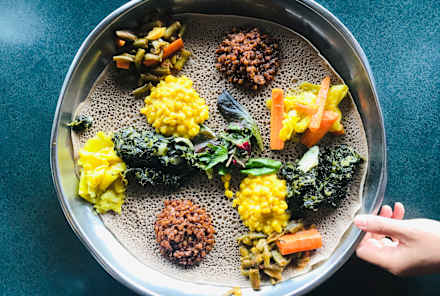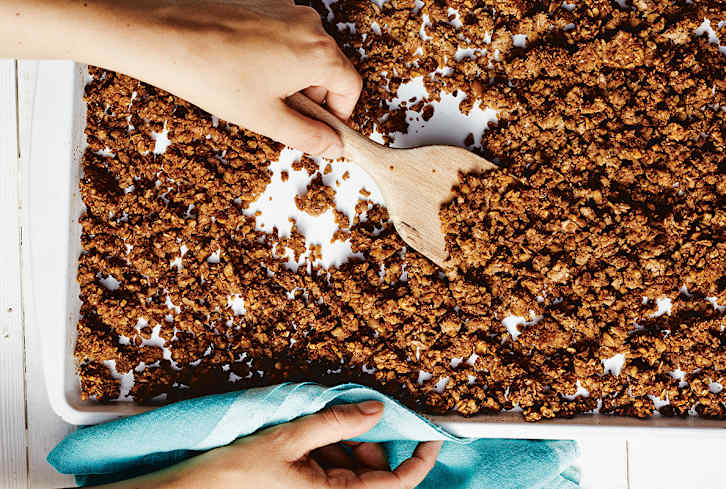Advertisement
Everything You Need To Know About Konjac Flour

Let's be real—pasta is delicious. However, if you follow a lower-carb diet, your classic pasta options may be replaced with zucchini, squash, and lentil noodles. While these alternatives can certainly be tasty, sometimes you want something that resembles pasta just a bit more. Enter your new favorite: Shirataki noodles, made from konjac flour, which is the zero-carb noodle substitute that's bound to become your new pantry staple. Below, see everything you need to know about this gluten-free flour and how to use it.
What is konjac flour?
While it may seem new to Western grocery stores, konjac flour has been around for centuries. "Amorphophallus konjac is a tuber crop grown in South Asian countries and has been used as food in China and Japan for more than 1,000 years," explains Mia Syn, M.S., R.D. "The majority of konjac flour originates from China and Japan. Konjac flour is created by slicing and drying the corms of the Amorphophallus konjac plant, and then milling the dried result."
The corm (the underground plant stem) itself is extremely high fiber and makes for a great thickener in recipes—kind of like a gelatin substitute. Tessa Nguyen, R.D., LDN, shares that konjac is "commonly eaten in a jelly form and worked into different dishes, savory and sweet, across East and Southeast Asian dishes."
What are the main benefits of konjac flour?
Since konjac flour is so high in fiber, you can reap several benefits by adding it to your day-to-day. Below are just a few reasons to make it a staple in your diet:
It may keep you fuller, longer.
"Konjac is high in soluble fiber, which attracts water and turns to gel during digestion," says Syn. "This helps slow digestion and increase feelings of satiety. It, therefore, may support weight management."
It could help support regular bowel movements.
A 2006 study published in Journal of the American College of Nutrition found that adding glucomannan1—which is the type of soluble fiber present in high quantities in the konjac root—to a low-fiber diet helped to prevent constipation and increased bowel movements by up to 30%.
It may reduce cholesterol.
"Some types of soluble fiber may help lower the risk of heart disease," says Syn. "A 2008 systematic review2 found that konjac may help lower total cholesterol, LDL (bad cholesterol), and triglycerides, so it, therefore, may help support heart health."
It might help manage diabetes.
Since konjac flour doesn't spike your blood sugar the way regular pasta does, adding it to your diet as a noodle replacement may help manage diabetes. A 2004 study found that konjac helped to lower blood sugar3 in hyperglycemic mice—however, there are no human studies to date. Still, the findings are promising.
What are some downsides of using konjac flour?
"Because of its high fiber content, overconsumption of konjac flour can result in gastrointestinal discomfort like abdominal pain and loose stools," says Syn, who says adding more water to your diet and then slowly reducing your intake of konjac can help with this potential issue.
"When using konjac flour as a thickening agent in recipes like soups and sauces, you can substitute with tapioca flour, which is a lower-fiber alternative," she adds. However, overall, konjac is a generally healthy ingredient that shouldn't cause dramatic side effects.
Where can I buy konjac flour?
Since this ingredient is less common in Western culture, you may not find konjac flour at your local grocery store. Instead, Syn suggests looking at specialty Asian food stores or on Amazon. Some nutritionist-approved favorite brands include Miracle Noodle, Nasoya, and Konjac Foods.
How can I use konjac flour in my recipes?
You can always buy packaged shirataki noodles and cook them just as you would regular pasta, adding the sauces and toppings of your choice, explains Nguyen.
Other than that, she suggests buying konjac jelly, which consists of small bits of glutinous konjac root. "My favorite way to eat konjac jelly is from my time spent living in South Korea," she says. "Konjac jelly is diced into bite-sized pieces and mixed with green onions, soy sauce, apple cider vinegar, sugar, gochugaru (spicy red pepper powder), sesame oil, and toasted sesame seeds. It's best served as a chilled side dish with rice."
Syn also enjoys using konjac flour in baking. It isn't a substitute for wheat flour, but it can be added to traditional baked goods as a thickening agent, in order to increase your recipe's dietary fiber content.
Bottom line.
Konjac flour can serve as a great high-fiber, low-carb substitute. Thanks to its high fiber content, it may offer a number of benefits. However, avoid overdoing it, or you could deal with gastrointestinal issues. It's a fantastic thickening agent and is useful in a variety of dishes.

Why Nutrition Is Key To Changing Your Relationship With Alcohol
Brooke Scheller, DCN, CNS

Why Alcohol Sabotages Your Gut Health & How To Get Back On Track
Brooke Scheller, DCN, CNS

Why Nutrition Is Key To Changing Your Relationship With Alcohol
Brooke Scheller, DCN, CNS

Why Alcohol Sabotages Your Gut Health & How To Get Back On Track
Brooke Scheller, DCN, CNS

Why Nutrition Is Key To Changing Your Relationship With Alcohol
Brooke Scheller, DCN, CNS

Why Alcohol Sabotages Your Gut Health & How To Get Back On Track
Brooke Scheller, DCN, CNS

Why Nutrition Is Key To Changing Your Relationship With Alcohol
Brooke Scheller, DCN, CNS

Why Alcohol Sabotages Your Gut Health & How To Get Back On Track
Brooke Scheller, DCN, CNS

